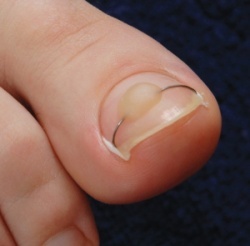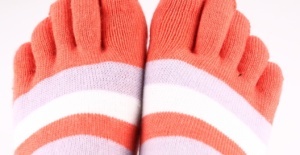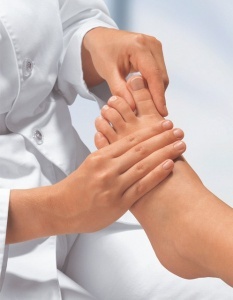An ingrown nail is a common occurrence. This is not just a cosmetic defect, but a disease that brings discomfort and pain. A damaged finger can become infected and inflamed. The thumbs of the foot are most often affected.
Symptoms of ingrown nails
 When the corners of the nail plate only begin to grow, the edge of the finger slightly blushes and swells, becoming painful. If a finger appears on the finger at the point of contact with the fingernail, a bright or yellowish liquid begins to form from it.
When the corners of the nail plate only begin to grow, the edge of the finger slightly blushes and swells, becoming painful. If a finger appears on the finger at the point of contact with the fingernail, a bright or yellowish liquid begins to form from it.
As a result of infection, the finger turns redder, the swelling becomes strained.
Increases local temperature, pus begins to stand out. Perhaps the development of a panic, an abscess and even an osteomyelitis with a lesion of the finger bone.
Reasons for growing
- Uncomfortable shoes: most often this problem concerns women. Shoes with narrow socks squeeze the nails on the fingers and hinder their natural growth. The result is an ingrown toenail. In addition, because of tight shoes, the thumb( valgus deformation) can deform, which is also the cause of the ailment.
- Wrong pedicure: excessive rounding of the nail corners leads to the fact that they gradually grow into the skin.
- Nail shape: the hereditarily conditioned form of the nail can predispose to this unpleasant phenomenon. If the nails are wide, noticeably expanding upwards, that is, the risk of their ingrowth.
- Leg injuries: when a heavy object falls on the leg, the shape of the nail plates may change, the growth zone is damaged.
- Fungus of the foot and toes also affects the nail growth zone, a similar pattern can be observed with hypo- and beriberi.
- Sudden increase in weight, which is especially characteristic of pregnant women, leads to deformation of the toes and ingrown toenail.
In advanced cases, you may need surgical treatment, but until this happens, you can try to get rid of the ailment in people's ways.
Traditional methods of treatment
Salt baths
In the pelvis pour hot water, dissolve in it a handful of large salt( sea or cooked).
Steam in salted water for 20 minutes. This procedure will reduce swelling and pain.
When the nail plates are softened, the ingrown corner should be slightly raised and a small piece of cotton wool placed under it so that it does not crash into the tissue.
As with the ingrown nail, it is possible to steam out the legs in a solution of furacilin or manganese.
These agents have an antimicrobial effect and prevent infection of the finger.
Tray based on chamomile pharmacy:
For 2 liters of boiling water take 6 tbsp.spoons of chamomile, brew for one hour. Then the infusion should be reheated and kept in it legs until the liquid cools.
After the procedure, dry the feet with a towel, carefully cut off the sharp angle of the nail, growing into the skin. Between the skin of the finger and the angle, it is also recommended to lay a little cotton wool.
You can similarly use a decoction or infusion of St. John's wort.
Compress with butter
With ingrown nails, the treatment with butter helps to soften the finger tissues and the nail plate. The fingertip should be filled with oil and put on the affected finger. From above heat a leg with a woolen toe or wrap it with a towel. Compress should be done before bedtime, and shoot - in the morning. Every morning, we must try to push back the growing corner.
Treatment with fat
Pork unbroken fat melt over a candle and drip it onto a sick finger. Repeat two times a day until the symptoms of inflammation abate.
Ointment with garlic, onion and wax
 Take a tablespoon of grated onion, crushed garlic, crushed aloe leaves and melted butter. Add a teaspoon of natural beeswax and mix everything. Wax has a bactericidal and anti-inflammatory effect, and also has a wound healing effect.
Take a tablespoon of grated onion, crushed garlic, crushed aloe leaves and melted butter. Add a teaspoon of natural beeswax and mix everything. Wax has a bactericidal and anti-inflammatory effect, and also has a wound healing effect.
Cook for 3-5 minutes, stirring with a wooden spoon.
Lightly cool, thickly lubricate ingrown toenail and inflamed skin of the finger. From above, the finger should be wrapped with a cabbage leaf or just a film, bandaged and warmed with a woolen toe. Leave it overnight. Repeat daily until pain and inflammation disappear.
Application of Aloe
Cut the aloe leaf along, flesh attach to the aching finger and bandage overnight. In the morning remove the bandage. Repeat every day.
How to treat an ingrown nail with suppuration?
How to treat an ingrown toenail if the finger is inflamed?
When there is severe swelling, pain, pus is released, it is better to consult a doctor. If this is not possible, then the wound should be disinfected with hydrogen peroxide.
The following folk remedy will help: Cut a piece of black bread and mix it with honey. The resulting mixture to lubricate the inflamed wound on the finger, top to put on a bandage. This drug has a pulling and anti-inflammatory effect.
Tip: If possible, you should give the nail a piece of corn with the corners, otherwise they will grow. Then cut the nail exactly, and corners to file.
When should I see a doctor?

. Medical care should be treated in the following cases:
- occurrence of severe pulsating or twitching pain at the site of inflammation, significant swelling of the finger;
- fever, weakness, malaise, headache, if they occur against the background of the inflammation of the finger;
- if more than five years have passed since the introduction of the last tetanus toxoid vaccine;
- with reduced immunity and other diseases leading to disorders of the healing process( diabetes mellitus, circulatory insufficiency, leg vessel disease).
Prevention of ingrown nail
With ingrown toenails, treatment is usually lengthy and time-consuming. Therefore, it is better to prevent the onset of an illness.
For prevention, the following rules must be observed:
- Wear comfortable shoes of the appropriate size.
- Do not round the nail corners too much. It is best to leave them as a rectangle. Sharp corners can be slightly trimmed with a file.
- Avoid injury.
- In public baths use slates to not catch a fungus.
- Control your weight.
Tip: if you have very tough nails, you can use the following technique. In the center of the nail plate, make a small pit with a file. As a result, the center begins to compact, and not the side edges of the nail. This will prevent the ingrowth of the edges.
The above recipes and tips will help prevent inflammation and restore the normal growth of the nail plate.
